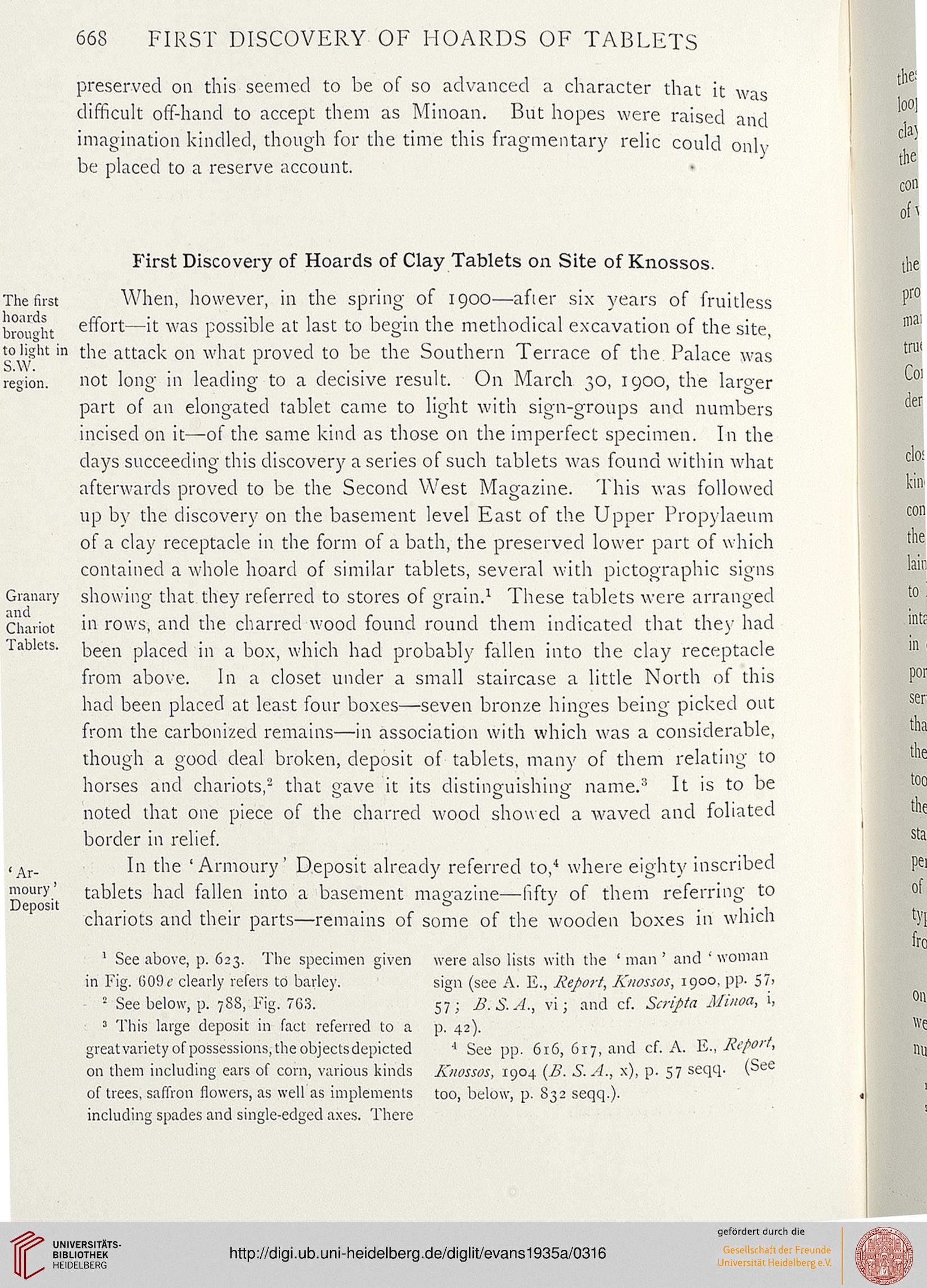668
FIRST DISCOVERY OF HOARDS OF TABLETS
preserved on this seemed to be of so advanced a character that it was
difficult off-hand to accept them as Minoan. But hopes were raised and
imagination kindled, though for the time this fragmentary relic could only
be placed to a reserve account.
The first
hoards
brought
to light in
S.W.
region.
Granary
and
Chariot
Tablets.
'Ar-
moury '
Deposit
First Discovery of Hoards of Clay Tablets on Site of Knossos.
When, however, in the spring of 1900—after six years of fruitless
effort—it was possible at last to begin the methodical excavation of the site,
the attack on what proved to be the Southern Terrace of the Palace was
not long in leading to a decisive result. On March 30, 1900, the larger
part of an elongated tablet came to light with sign-groups and numbers
incised on it—of the same kind as those on the imperfect specimen. In the
days succeeding this discovery a series of such tablets was found within what
afterwards proved to be the Second West Magazine. This was followed
up by the discovery on the basement level East of the Upper Propylaeum
of a clay receptacle in the form of a bath, the preserved lower part of which
contained a whole hoard of similar tablets, several with pictographic signs
showing that they referred to stores of grain.1 These tablets were arranged
in rows, and the charred wood found round them indicated that they had
been placed in a box, which had probably fallen into the clay receptacle
from above. In a closet under a small staircase a little North of this
had been placed at least four boxes—seven bronze hinges being picked out
from the carbonized remains—in association with which was a considerable,
though a good deal broken, deposit of tablets, many of them relating to
horses and chariots,2 that gave it its distinguishing name.3 It is to be
noted that one piece of the charred wood showed a waved and foliated
border in relief.
In the 'Armoury' Deposit already referred to,4 where eighty inscribed
tablets had fallen into a basement magazine—fifty of them referring to
chariots and their parts—remains of some of the wooden boxes in which
1 See above, p. 623. The specimen given
in Fig. (iOi)t' clearly refers to barley.
' See below, p. 7SS, Fig. 763.
3 This large deposit in fact referred to a
great variety of possessions, the objectsdepicted
on them including ears of corn, various kinds
of trees, saffron flowers, as well as implements
including spades and single-edged axes. There
were also lists with the ' man ' and ' woman
sign (see A. E., Report, Knossos, 1900. pp. 57>
57; B.S.A., vi; and cf. Serif ta Minoa, i,
p. 42).
'' See pp. 616, 6ry, and cf. A. E., Report,
Kuossos, 1904 (B. S. A., x), p. 57 seqq- (Sec
too, below, p. 832 seqq.).
FIRST DISCOVERY OF HOARDS OF TABLETS
preserved on this seemed to be of so advanced a character that it was
difficult off-hand to accept them as Minoan. But hopes were raised and
imagination kindled, though for the time this fragmentary relic could only
be placed to a reserve account.
The first
hoards
brought
to light in
S.W.
region.
Granary
and
Chariot
Tablets.
'Ar-
moury '
Deposit
First Discovery of Hoards of Clay Tablets on Site of Knossos.
When, however, in the spring of 1900—after six years of fruitless
effort—it was possible at last to begin the methodical excavation of the site,
the attack on what proved to be the Southern Terrace of the Palace was
not long in leading to a decisive result. On March 30, 1900, the larger
part of an elongated tablet came to light with sign-groups and numbers
incised on it—of the same kind as those on the imperfect specimen. In the
days succeeding this discovery a series of such tablets was found within what
afterwards proved to be the Second West Magazine. This was followed
up by the discovery on the basement level East of the Upper Propylaeum
of a clay receptacle in the form of a bath, the preserved lower part of which
contained a whole hoard of similar tablets, several with pictographic signs
showing that they referred to stores of grain.1 These tablets were arranged
in rows, and the charred wood found round them indicated that they had
been placed in a box, which had probably fallen into the clay receptacle
from above. In a closet under a small staircase a little North of this
had been placed at least four boxes—seven bronze hinges being picked out
from the carbonized remains—in association with which was a considerable,
though a good deal broken, deposit of tablets, many of them relating to
horses and chariots,2 that gave it its distinguishing name.3 It is to be
noted that one piece of the charred wood showed a waved and foliated
border in relief.
In the 'Armoury' Deposit already referred to,4 where eighty inscribed
tablets had fallen into a basement magazine—fifty of them referring to
chariots and their parts—remains of some of the wooden boxes in which
1 See above, p. 623. The specimen given
in Fig. (iOi)t' clearly refers to barley.
' See below, p. 7SS, Fig. 763.
3 This large deposit in fact referred to a
great variety of possessions, the objectsdepicted
on them including ears of corn, various kinds
of trees, saffron flowers, as well as implements
including spades and single-edged axes. There
were also lists with the ' man ' and ' woman
sign (see A. E., Report, Knossos, 1900. pp. 57>
57; B.S.A., vi; and cf. Serif ta Minoa, i,
p. 42).
'' See pp. 616, 6ry, and cf. A. E., Report,
Kuossos, 1904 (B. S. A., x), p. 57 seqq- (Sec
too, below, p. 832 seqq.).




